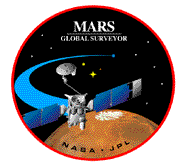 Mars Global Surveyor Data Archives
Mars Global Surveyor Data Archives
Distributed By The NASA Planetary Data System
Mars Global Surveyor is an orbiter carrying the Mars Orbiter Camera (MOC), the Mars Orbiter Laser Altimeter (MOLA), the Thermal Emission Spectrometer (TES), the Magnetometer/Electron Reflectometer (MAG/ER), the Radio Science Subsystem (RSS), the Accelerometer, and the Mars Relay. Read more about this mission on the MGS Home Page.
Data acquired by these instruments during systematic mapping of Mars will be released to the science community through the Planetary Data System (PDS) at six-month intervals, beginning in October 1999. The instruments also acquired data during orbit insertion, and some of these data products are already available or will be shortly. PDS provides these data products on CD-ROM volumes free of charge to NASA-funded investigators; contact Susan Slavney for more information. Others may obtain them from the National Space Science Data Center (NSSDC) for a nominal fee. See the Data Distribution Policy and Schedules for details.
What's New | MGS Data Products Online | MGS Archive Plan | Mission History | PDS Catalog Information
What's New
October 30, 2001. New TES Mapping Phase and Extended Mission data covering 1/1/01 through 4/1/01 are now available.
MGS Data Products Online
- Mars Orbiter Laser Altimeter (MOLA)
- MOLA raw (AEDRs) and corrected (PEDRs) altimetry profile data
products for the Assessment Orbits and Science Phasing Orbits are
available at this site. Archive volumes include software for accessing
the binary PEDR files.
- Mars Orbiter Camera (MOC)
- This web site, maintained by the PDS Imaging Node, provides access
to raw MOC image data plus full and reduced resolution JPEG versions,
along with JPEG "context" images created from Viking data.
- Thermal Emission Spectrometer (TES)
- Raw and calibrated radiance data products acquired during the
pre-mapping period are online.
- Radio Science
- The PDS Geophysics Subnode maintains this site for reduced Radio
Science data products, including results from radio occultation and
gravity investigations.
- SPICE
- The SPICE kernel files contain geometric and much other ancillary
information needed to recover the full value of science instrument data.
- Magnetometer / Electron Reflectometer (MAG/ER)
- Processed high resolution data from the SPO-1 and SPO-2 phases of
the mission are available from the PDS Planetary Plasma Interactions
(PPI) Node.
- Accelerometer
- Raw accelerometer data from Aerobraking Phases 1 and 2 are online at
the PDS Atmospheres Node. This archive has passed peer review.
- The MGS Science Sampler CD-ROM
- The Sampler contains data products acquired mostly during the Assessment Orbits by MOC, MOLA, TES, and MAG/ER, plus the pre-MGS spherical harmonic gravity models which will be updated with data from the Radio Science Subsystem.
MGS Archive Plan
The Mars Global Surveyor Project data archiving activities are described in the MGS Archive Generation, Validation, and Transfer Plan (R. Arvidson, E. Guinness, S. Slavney, and R. J. Springer, 1998, MGS Document #542-312) [Adobe PDF file, 101 Kb]. This document describes the archiving functions, sets forth the roles and responsibilities of the MGS Project, the Planetary Data System, and the National Space Science Data Center, and includes a schedule for the release of validated archives.
Mission History
MGS arrived at Mars on September 11, 1997 and entered a highly elliptical orbit. Aerobraking maneuvers were begun to slow the spacecraft and gradually circularize the orbit. On October 8, 1997, the spacecraft experienced difficulties related to a fracture in one of the solar panel damper arms whch caused excess vibrations in the solar panel. While the problem was being evaluated, the spacecraft was put in a higher orbit to avoid passing through the atmosphere and placing more stress on the panel. On November 7, 1997, aerobraking was begun again at a slower rate. During the aerobraking hiatus (October 13 through November 7), the MGS instrument panel was pointed towards Mars and data were collected. These data cover orbits 19 through 36, known as the assessment orbits. The data products were published on the MGS Science Sampler CD-ROM.
In order to place the spacecraft in an optimal orbit for science observations, aerobraking was halted again on March 27, 1998 and resumed on September 14, 1998. Again, science data were acquired during these orbits, which are known as the Science Phasing Orbits. (See MGS Data Products above).
The Mapping Phase of the MGS mission began on March 9, 1999, and will continue for a little more than one Mars year, until January 31, 2001. During mapping, the spacecraft orbits the planet with a period of about 118 minutes, at an average altitude of 400 km.
PDS Catalog Information
When MGS data sets are formally released, they are entered in the Planetary Data System Data Set Catalog for online searching. MGS data producers submit the descriptive information about the mission, spacecraft, instruments, and data sets for inclusion in the catalog. The information is also part of the archive volumes. To provide consistency across the various MGS archives, the latest versions of the mission and spacecraft catalog objects are maintained at this site by the Geosciences Node.
MGS Mission catalog object: mission.cat (last updated 4/6/01)
MGS Instrument Host (Spacecraft) catalog object: insthost.cat (last updated 3/30/00)
Target catalog objects: martgt.cat (Mars), deitgt.cat (Deimos), and photgt.cat (Phobos) (last updated 8/11/99)
References mentioned in the above files: ref.cat (last updated 1/30/01)
 |
This site is maintained by the Planetary Data System Geosciences Node at Washington University, St. Louis, Missouri. Questions and comments may be addressed to geosci@wunder.wustl.edu. This page was last updated on February 18, 2002. Usage statistics are available. |